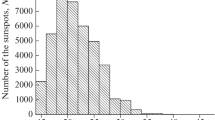Abstract
To investigate the relationship between solar activity and the large-scale axisymmetric magnetic field of the Sun, we inferred from sunspot data over the period 1964–1985 a latitude–time distribution of magnetic field associated with active regions. This has been done allowing for both bipolar structure of the active regions and inclination of their axes to parallels of latitude, so the inferred magnetic field characterizes latitudinal separation of magnetic polarities which might be related to the large-scale magnetic field of the Sun according to the Babcock–Leighton model. The inferred magnetic field, A z, is compared with the longitude-averaged (zonal) magnetic field of the Sun, B z, derived from series of magnetograms obtained at Mount Wilson Observatory in the years 1964–1976, and at Kitt Peak National Observatory during the period from 1976 to 1985. The inferred magnetic field, A z, exhibits a complex structure distribution of magnetic polarities with respect to latitude and time. Apart from concentration of the different polarity magnetic fields inside the high- and low-latitude portions of the sunspot belts, bipolar active regions produce an intensive, shorter-scale component of the magnetic field which varies on the time scale of about 2 years. Such a short-term variation of A z reveals substantial correlation with the short-term component of B z which has the form of the poleward-drifting streams of magnetic field. Most significant correlation takes place between the short-term variations of A z occurring at latitudes below 20° and those of the large-scale magnetic fields occurring at middle latitudes of 40–50°. Moreover we analyze harmonic coefficients a l and b l obtained by expanding A z and B z into series in terms of the spherical harmonics. Power spectra of the time-dependent harmonic coefficients indicate that both A z and B z reveal a number of resonant modes which oscillate either with the 22-year period in the case of the anti-symmetric (odd-l) modes or with periods of about 2 years in the case of the symmetric (even-l) modes, but the resonant modes of A z have significantly larger values of the spherical harmonic degree l (and, hence, smaller spatial scales) as compared to those of B z. It is found that there is a close relationship between the harmonic coefficients b l and a m for which either m−l≈16 (even l=4,...,10) or m−l=4 (odd l=5,...,15).
Similar content being viewed by others
References
Babcock, H. W.: 1961, Astrophys. J. 133, 572.
Benevolenskaya, E. E.: 1995, Solar Phys. 161, 1.
Benevolenskaya, E. E.: 1998, Astrophys. J. 509, L49.
Brunner, W.: 1930, Astron. Mitt. Zürich, No 124.
Bumba, V.: 1976, in V. Bumba and J. Kleczek (eds.), Basic Mechanisms of Solar Activity, D. Reidel Publ. Co., Dordrecht, Holland, p. 47.
Bumba, V. and Howard, R.: 1965, Astrophys. J. 141, 1502.
Durney, B. R.: 1998, Solar Phys. 180, 1.
Erofeev, D. V.: 1998, Solar Phys. 182, 21.
Erofeev, D. V.: 1999, Solar Phys. 186, 431.
Gokhale, M. H., Javaraiah, J., Kutty, K. N., and Varghese, B. A.: 1992, Solar Phys. 138, 35.
Howard, R.: 1991a, Solar Phys. 132, 49.
Howard, R.: 1991b, Solar Phys. 136, 251.
Howard, R. and LaBonte, B. J.: 1981, Solar Phys. 74, 131.
Latushko, S.: 1994, Solar Phys. 149, 231.
Leighton, R. B.: 1964, Astrophys. J. 140, 1547.
Murray, N. and Wilson, P. R: 1993, Solar Phys. 142, 221.
Sheeley, N. R.: 1966, Astrophys. J. 144, 723.
Snodgrass, H. B. and Dailey, S. B.: 1996, Solar Phys. 163, 21.
Stenflo, J. O.: 1972, Solar Phys. 23, 307.
Stenflo, J. O.: 1988, Astrophys. Space Sci. 144, 321.
Stenflo, J. O.: 1994, in R. J. Rutten and C. J. Schrijver (eds.) Solar Surface Magnetism, Kluwer Academic Publishers, p. 365.
Stenflo, J. O. and Güdel, M.: 1988, Astron. Astrophys. 191, 137.
Stenflo, J. O. and Vogel, M.: 1986, Nature 319, 285.
Stepanian, N. N.: 1985, Izv. Krymsk. Astrofiz. Obs. 71, 62 (in Russian).
Wang, Y.-M. and Sheeley, N. R.: 1989, Solar Phys. 124, 81.
Wang, Y.-M., Nash, A. G., and Sheeley, N. R.: 1989, Science 245, 712.
Author information
Authors and Affiliations
Rights and permissions
About this article
Cite this article
Erofeev, D. The Relationship Between Solar Activity and the Large-Scale Axisymmetric Magnetic Field. Solar Physics 198, 31–50 (2001). https://doi.org/10.1023/A:1005237028902
Issue Date:
DOI: https://doi.org/10.1023/A:1005237028902




